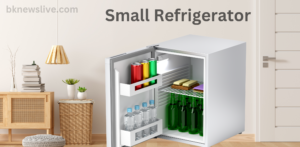Introduction
A small refrigerator is a compact and space-saving appliance that provides convenience without compromising on essential cooling needs. Whether you’re a student in a dorm, a professional in an office, or someone living in a small apartment, a small fridge can be the perfect addition to your space. But with so numerous options available, how do you choose the stylish one? This guide will help you understand everything about small refrigerators, from types and features to maintenance and best models for different needs.
Types of Small Refrigerators
Mini Fridges
Mini fridges are the most common small refrigerators, often used in dorm rooms and offices. They are lightweight, energy-efficient, and ideal for storing beverages and snacks.
Compact Refrigerators
These are slightly larger than mini fridges and can accommodate more items, including fresh food and frozen goods. They often include a small freezer compartment.
Portable Refrigerators
Designed for travel and outdoor use, portable refrigerators run on both AC and DC power, making them ideal for road trips, camping, and RVs.
Beverage Coolers
These are specifically designed to store and chill beverages like soda, beer, and wine. They usually come with glass doors and adjustable shelves.
Key Features to Look for in a Small Refrigerator
Size and Capacity
Consider how much storage space you need and where you will place the fridge. Compact fridges offer more space, while mini fridges are better for tight spots.
Energy Efficiency
Look for Energy Star-rated models to save on electricity bills while reducing environmental impact.
Cooling Technology
Compressor-based fridges provide powerful cooling, while thermoelectric ones are quieter but less effective in hot environments.

Storage and Shelving
Lorem ipsum dolor sit amet, consectetur adipiscing elit. Ut elit tellus, luctus nec ullamcorper mattis, pulvinar dapibus leo.If you’re placing the fridge in a bedroom or office, opt for a quieter model.
Best Small Refrigerators for Different Needs
- For Dorm Rooms: Look for an affordable and energy-efficient mini fridge.
- For Offices: A compact fridge with a lockable door is a great option.
- For RVs and Camping: A portable fridge with dual power options (AC/DC) is best.
- For Small Apartments: A stylish, space-saving compact fridge works well.
How to Maintain a Small Refrigerator
Regular Cleaning, Temperature Settings, Defrosting Tips, Troubleshooting Common Issues,
Wipe down the interior and exterior regularly to prevent odors and bacteria buildup. Set the fridge temperature between 37-40°F and the freezer at 0°F for optimal performance. Manually defrost your fridge every few months to prevent ice buildup. If your fridge isn’t cooling properly, check the power source, thermostat settings, and air vents.
Pros and Cons of Small Refrigerators
Advantages
- Space-saving
- Energy-efficient
- Portable and versatile
Disadvantages
- Limited storage
- Some models lack a freezer
- Can be noisy in certain cases
Budget-Friendly Small Refrigerators
Affordable options are available under $150, while high-end models with advanced features can go up to $500 or more.
Eco-Friendly and Energy-Efficient Small Refrigerators
Energy Star Ratings
Look for Energy Star-certified fridges to reduce energy consumption.
Environmental Impact
Opt for eco-friendly refrigerants and sustainable designs to minimize environmental harm.
Conclusion
A small refrigerator is an excellent investment for convenience, efficiency, and practicality. Whether you need one for your dorm, office, RV, or apartment, there’s a perfect model out there for you. Consider the key features, energy efficiency, and budget before making a purchase.
FAQs small refrigerator
1. What is the ideal size for a small refrigerator?
- The size depends on your needs, but most small refrigerators range between 1.7 to 4.5 cubic feet.
2. Are small refrigerators energy efficient?
Many models are Energy Star certified, which helps reduce energy consumption.
3. How often should I defrost my mini fridge?
Ideally, every 3-6 months, or when ice buildup exceeds 1/4 inch.
4. Can a small refrigerator be used as the main fridge?
It depends on your needs. For single users or minimal storage, it can work, but it’s not ideal for families.
5. What is the best small refrigerator for a dorm room?
Look for a compact, energy-efficient model with a freezer compartment and adjustable shelves.















2 thoughts on “Small Refrigerators: The Ultimate Guide to Everything You Need to Know 01”